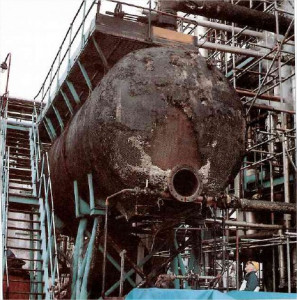A jet flame occurred during maintenance (cleaning) works in a company producing Nitrotoluene Isomers in a continuous Meissner plant. Residues from this process were collected then distilled in a still base to recover usable nitrotoluene. The still base had accumulated tarry residues that were slowing the rate of distillation and cleaning was decided.
The 7.9 m long, 2.7 m diameter still base was opened and residues were heated (for 3 h) via an internal steam battery that was submerged below the tarry residue. The steam supply was at about 135 psig corresponding to a steam temperature of approximately 180°C. At the same time, raking was taking place with the use of a metal rake.
At 13.22 hrs a jet flame erupted from the front manhole of the vessel (surface emissive power of about 1000kw/m2 which lasted 1 min). It impinged on a nearby control building of wooden construction and a large brick built office behind. The jet consumed the control building in its path killing 2 employees instantly. Two others in the control building later died from burns. The jet caused a fire in the office block which produced smoke and fume.
The on-site fire alarm was sounded, the emergency services were called and employees followed the company’s fire evacuation and assembly procedure. Internal fire crew responded to extinguish fires at the still base and the control cabin after the jet had subsided. A young female employee was found in the building approximately 30 minutes after the initiating event. She had been overcome by fume and had suffered a hearth attack from which she did not recover. 3 other employees sustained reportable injuries. One was detained in hospital with 15% burns and a number of other employees suffered psychological effects resulting from trauma and shock. Fire damage was confined to the site and water used to extinguish fires at the still base, control cabin and office block were contained and did not contaminate the river and canal which run through and around the factory site. The damage were extensive and the costs were evaluated at 1.5 Meuros. There were no injuries to persons or damage to property off-site.
The HSE investigation concluded that the incident resulted from self heating and runaway exothermic decomposition of 4 t of thermally unstable residues (containing dinitrotoluene and nitrocresols) in contact with heated steam pipes. The report underlined management failures to provide a safe system of work for removal of potentially unstable highly energetic residue from a vessel which had not been opened and cleaned for 30 years. These failings were characterised by a number of errors including:
1/ Maintenance Procedures : Failure to analyse the sludge and atmosphere within the vessel prior to cleaning and failure to isolate the still base inlet prior to the work commencing.
2/ No Reaction / Product Testing for thermal stability and effect of impurities
3/ Inadequate measurement of sludge temperature, because of the position of the controlling thermocouple (above sludge level). Even though, the sludge was too thick to allow good convection circulation, so the heat was uneven (and the sludge composition not uniform).
4/ Faulty pressure reducing valve on steam supply supplied steam at a higher temperature than anticipated.
5/ Permit to Work Systems : 2 permits were issued for the removal of the manlid and one permit for the blanking of the still base inlet. No permit to work was ever issued for the task of raking out the still base using a metal rake (no flameproof tool) in a vessel still containing flammable vapours.
6/ plant layout : wrong positioning of occupied buildings leading to casualties within control room and administration block.
The operator strengthened area production management to ease the workload of middle managers. Risk management consultants were brought in to review changes proposed to the Meissner plant before start up.





